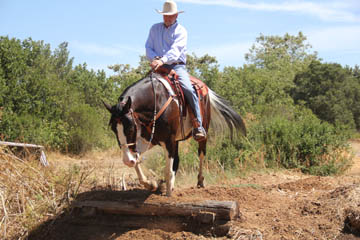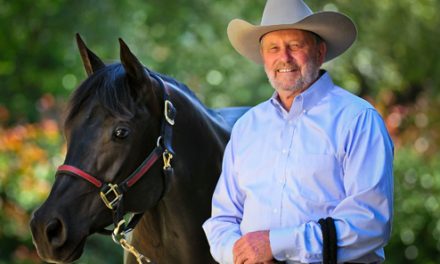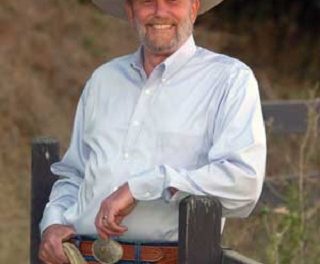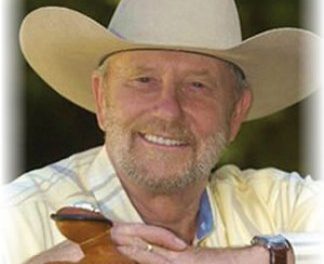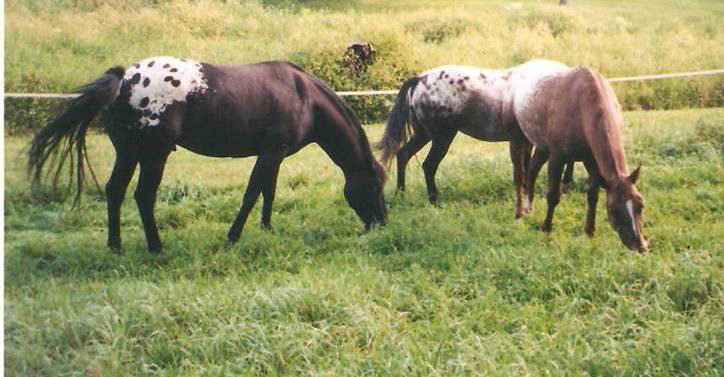
Another principle of natural horsemanship that has become accepted is the practice of de-spooking. Back when I first talked about de-spooking a horse, it was an unknown concept. Now it is a common term and simply means we are taking the spook out of the horse. All horses have the flight instinct and de-spooking is getting a horse to accept pressure. What I see now is that people are trying to make their horses safer by desensitizing or de-spooking them. They often end with dull horses because they are not willing to increase the pressure until the horse gives. The same is true when doing ground work; a horse will become dull when he has not learned to give to pressure. A lot of us are not willing to get out of our comfort zone and add more pressure as it is needed to get the horse to move his feet, move sideways or do whatever it is we are asking the horse to do. Also, it is just as important to release immediately when the horse does give or accept for even a moment.
Someone recently asked me about the Extreme Mustang Make Over Challenge. I think it is actually a good program but it has gotten really competitive in that the horses are pushed to do a lot in a very short time. Thirty years ago when I started working with problem horses, I found that people were moving way too fast with their training. Even a horse that shows real talent who is moved too fast will, six or eight months down the road, start showing holes in the training such as bucking, rearing or becoming dull to the training aids. What I see in these events is, no matter the breed of horse, and I don’t care if it is wild or domestic, a horse is a horse and each horse has its own personality and learning curve. Some horses get it more quickly than others. Some Mustangs do really well but the training has been really fast. They are put into bridles too soon and are asked to do a lot of things too soon. There are a lot of good trainers out there doing really good things but to get these Mustangs to do what they do in so short a time, requires that the horses be pushed. I would rather see a trainer take a little more time and establish the basics. Years ago, I patted myself on the back when I would get a horse in the round pen and work with it and by the third ride I was out on the trail. But, I had to be cautious about where my legs were, the horse was not relaxed and my safety was at risk. What I found was that I might be riding the horse in a walk, trot or canter but I couldn’t lead the horse quietly. I couldn’t pick up his feet and he was spooky and edgy. Taking the time to do each step is worth the effort.
Someone may say, “Well Charles, you participate in the colt starting contests.” Yes, I do but I start with the very basics and if the horse does not accept the very basic training, I don’t move on. If the horse won’t let me ride him, there is no way that I can manipulate him to let me get on, no matter how good a rider I am. In some contests I have had a horse that was nervous and jumpy and because of my expertise and by taking several sessions to work with him, I have been able to get a saddle on and I have won the contest. It may take me three sessions to get a horse to let me put the saddle on and be relaxed. A horse I worked with up in Canada did really well when working to the left but anything attempted on the right side was a problem. Even touching his face spooked him and he wanted to go up in the air. A horse like that is just going to take longer to work with. I rode that horse in the competition but obviously it didn’t do well. The point is, the horse is only going to let me get done what I get done. I can only move onto the next level of training when the horse has accepted and learned the current lesson.
Someone asked me a couple of years ago about my favorite breed. My favorite breed is a good minded horse. I’ve had Arabs in here that I have loved and had a great time working with because they have good minds, they want to learn and they have a good work ethic. I’ve had wonderful Quarter horses and a few years ago we rescued a National Show Horse that just loved to work and was really good minded. I’m not picky about the breed. I had a Mustang in here that was willing and responsive and a fun horse to ride. It was one of my favorite horses to ride in training each day.
The point really is that the equipment doesn’t train the horse and neither does the exercise. It doesn’t make any difference who is working with the horse, you or any of the clinicians, including me. I do clinics and I teach the exercises that I find work well for me. They work because I build a foundation of training doing the exercises correctly and looking for a soft response, with the horses learning to give. When a horse is brought to the ranch for training and that horse is stiff as a board on the ground and under saddle, it ends up taking more time in training to get the horse soft again. Years ago, when I started working with problem horses I might have a horse that was a little pushy but no one had dulled it by pulling, pushing or using a training stick. Now I see horses that are quiet and easy to be around but they do not listen and move off pressure. I use a dressage stick or a training stick and when I bump a horse with my leg, a spur or a stick, it has to move off my leg. If it doesn’t, I’m going to increase the pressure. This is a really tough concept for some to accept but this is how horses learn.
Natural horsemanship has really gotten a foothold. We see it more with hunters and jumpers and even in the discipline of eventing. We are starting to see it more in the dressage barns where they are expecting the horses to be more obedient on the ground. They are finding that when a horse is more emotionally relaxed the horse will give a better performance. Natural horsemanship has been a positive movement but there is a down side. It comes down to two things. One, it is not the equipment that trains the horse, it is how we use that equipment. Two, it is not the exercise that trains the horse, it is doing the exercise correctly, increasing pressure when needed and immediately releasing the pressure when we get the response we are looking for.

